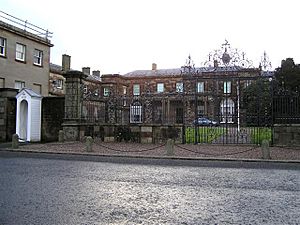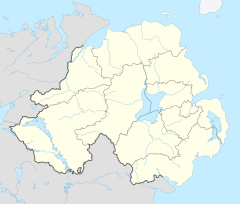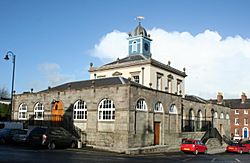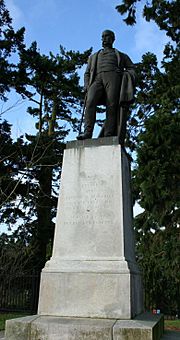Royal Hillsborough facts for kids
Quick facts for kids Royal Hillsborough
|
|
|---|---|
 Hillsborough Castle |
|
| Population | 3,952 (2011 Census) |
| District |
|
| County | |
| Country | Northern Ireland |
| Sovereign state | United Kingdom |
| Post town | HILLSBOROUGH |
| Postcode district | BT26 |
| Dialling code | 028 |
| EU Parliament | Northern Ireland |
| UK Parliament |
|
| NI Assembly |
|
Royal Hillsborough is a lovely village in County Down, Northern Ireland. Its name in Irish is Cromghlinn, which means 'Crooked Glen'. People often just call it Hillsborough. It's about 19 kilometers (12 miles) from the big city of Belfast.
The village is known for its beautiful Georgian architecture. This means many buildings were built in a style popular during the time of King George. Royal Hillsborough is also home to Hillsborough Castle. This castle is the official home for the British royal family when they visit Northern Ireland. It's also where the British Secretary of State for Northern Ireland lives.
Contents
History of Royal Hillsborough
How Hillsborough Got Its Name
Before the year 1661, this area was called Crumlin or Cromlin. This name came from the Irish words for 'crooked glen'.
Around 1661, the village was renamed Hillsborough. It was named after an English army officer, Sir Moses Hill. His son, Sir Arthur Hill, built a fort here in 1650. This fort helped control the road between Dublin and Carrickfergus. The Hill family later became important nobles, known as the Earls of Hillsborough.
Hillsborough Castle's Beginnings
The grand house we now know as Hillsborough Castle was built in 1770. It was made for The 1st Earl of Hillsborough. He later became the 1st Marquess of Downshire in 1789.
Important Monuments and Royal Status
A tall monument stands south of the village. It looks a lot like Nelson's Column in London's Trafalgar Square. This monument honors The 3rd Marquess of Downshire, who lived from 1788 to 1845. You can see it from many places around the village.
In 2007, Hillsborough won 3rd place in a gardening competition called Ulster in Bloom. This was for large villages.
In 2021, the village received a special honor. It was officially allowed to add "Royal" to its name. This happened because Hillsborough Castle is the official royal residence for Northern Ireland. So, it became "Royal Hillsborough" on October 20, 2021.
Local Government and Representation
How Royal Hillsborough is Governed
Until 2015, Hillsborough was part of Lisburn City Council. Now, it is part of the new Lisburn and Castlereagh District Council. This council helps manage local services for the area.
Royal Hillsborough is also part of larger areas for government. For the UK Parliament, it's in the Lagan Valley area. For the Northern Ireland Assembly, it's also in the Lagan Valley area. These areas choose people to represent them in government.
People of Royal Hillsborough
Population Facts
On March 27, 2011, a census counted 3,952 people living in Hillsborough and Culcavy.
- About 17.1% of the people were under 16 years old.
- About 20.6% were 65 years old or older.
- The population was almost evenly split between males (48.4%) and females (51.6%).
- About 3.1% of people aged 16–74 were looking for work but couldn't find it.
Places to Visit in Royal Hillsborough
- Hillsborough Castle: This is a two-story mansion built in the Georgian style. It was the home of the government from 1924 to 1973. Today, it is the official home for King Charles III and other Royal Family members when they visit Northern Ireland. The Secretary of State for Northern Ireland has also lived here since 1973. Important agreements, like the Anglo-Irish Agreement in 1985, were signed here. Former Prime Minister Tony Blair stayed here often during peace talks. Even President George W. Bush visited in 2003.
- Hillsborough Fort: This historic fort was built in 1650 by Sir Arthur Hill. It played an important role in the village's early history.
- Hillsborough Forest Park and Lake: This beautiful park is where the original fort residence of Lord Hillsborough was located. It's a great place to enjoy nature.
- International Oyster Festival: Each year, usually in September, Hillsborough hosts a big Oyster Festival. Thousands of people come to enjoy the fun! There are boat races, parachuting, garden parties, oyster eating, and Guinness drinking.
- Saint Malachy's Parish Church: This old church is a wonderful example of Gothic Revival architecture. It was built between 1760 and 1774 for The 1st Earl of Hillsborough. The church has two old organs from the 1700s and ten bells. It also has artworks by famous craftspeople of that time. Today, it is a church in the Church of Ireland Diocese of Down and Dromore.
Famous People from Royal Hillsborough
- Sir Hamilton Harty (1879–1941): He was a famous composer and conductor. His father was an organist at St. Malachy's Parish Church.
- Gloria Hunniford: This TV and radio presenter lived in Hillsborough for many years. Her daughter, Caron Keating, spent much of her childhood here.
- Frank Pantridge (1916–2004): He was a doctor and heart specialist born in Hillsborough. He invented the portable defibrillator, a device that can save lives.
- Richard Lyons (born 1979): He is a racing driver and a champion in the Formula Nippon racing series.
Railway History
Hillsborough's Old Train Station
The Hillsborough railway station opened on July 13, 1863. It was part of the Banbridge, Lisburn and Belfast Railway. The train line that went through the station belonged to the Great Northern Railway (Ireland).
The station closed on April 30, 1956. After it closed, buses took over the train services. Today, there is no sign of the old station. It was removed when a new dual carriageway (a road with two lanes in each direction) was built. The station used to be where this road crosses over Culcavey Road.
Sports in Royal Hillsborough
- Lisnagarvey Hockey Club: In 2005, this hockey club moved its home ground to the edge of Hillsborough.
- Downshire Young Men F.C.: This is a local football club in the area.
Climate in Royal Hillsborough
| Climate data for Hillsborough climate station (91m elevation) 1991–2020 averages | |||||||||||||
|---|---|---|---|---|---|---|---|---|---|---|---|---|---|
| Month | Jan | Feb | Mar | Apr | May | Jun | Jul | Aug | Sep | Oct | Nov | Dec | Year |
| Record high °C (°F) | 14.7 (58.5) |
15.8 (60.4) |
19.4 (66.9) |
22.8 (73.0) |
23.8 (74.8) |
28.1 (82.6) |
29.5 (85.1) |
28.4 (83.1) |
24.5 (76.1) |
21.1 (70.0) |
15.8 (60.4) |
14.5 (58.1) |
29.5 (85.1) |
| Mean daily maximum °C (°F) | 7.3 (45.1) |
7.8 (46.0) |
9.4 (48.9) |
11.7 (53.1) |
14.7 (58.5) |
17.1 (62.8) |
18.6 (65.5) |
18.3 (64.9) |
16.2 (61.2) |
12.8 (55.0) |
9.7 (49.5) |
7.7 (45.9) |
12.6 (54.7) |
| Mean daily minimum °C (°F) | 2.0 (35.6) |
1.8 (35.2) |
2.7 (36.9) |
4.2 (39.6) |
6.5 (43.7) |
9.3 (48.7) |
11.0 (51.8) |
10.9 (51.6) |
9.2 (48.6) |
6.8 (44.2) |
4.1 (39.4) |
2.2 (36.0) |
5.9 (42.6) |
| Record low °C (°F) | −12.2 (10.0) |
−7.8 (18.0) |
−10.0 (14.0) |
−4.9 (23.2) |
−3.3 (26.1) |
0.0 (32.0) |
2.5 (36.5) |
1.8 (35.2) |
−1.2 (29.8) |
−4.5 (23.9) |
−8.3 (17.1) |
−11.5 (11.3) |
−12.2 (10.0) |
| Average rainfall mm (inches) | 83.9 (3.30) |
65.3 (2.57) |
66.5 (2.62) |
57.6 (2.27) |
60.0 (2.36) |
69.7 (2.74) |
81.1 (3.19) |
83.2 (3.28) |
72.4 (2.85) |
91.9 (3.62) |
98.6 (3.88) |
87.4 (3.44) |
917.5 (36.12) |
| Average rainy days (≥ 1.0 mm) | 14.4 | 12.9 | 12.8 | 11.5 | 11.6 | 11.8 | 13.0 | 13.2 | 12.0 | 13.8 | 15.1 | 14.8 | 157.0 |
| Mean monthly sunshine hours | 44.8 | 72.0 | 106.7 | 153.5 | 194.4 | 159.7 | 150.1 | 152.0 | 119.2 | 94.3 | 60.1 | 38.3 | 1,345.2 |
| Source 1: metoffice.gov.uk | |||||||||||||
| Source 2: KNMI | |||||||||||||
See also
 In Spanish: Hillsborough and Culcavy para niños
In Spanish: Hillsborough and Culcavy para niños





